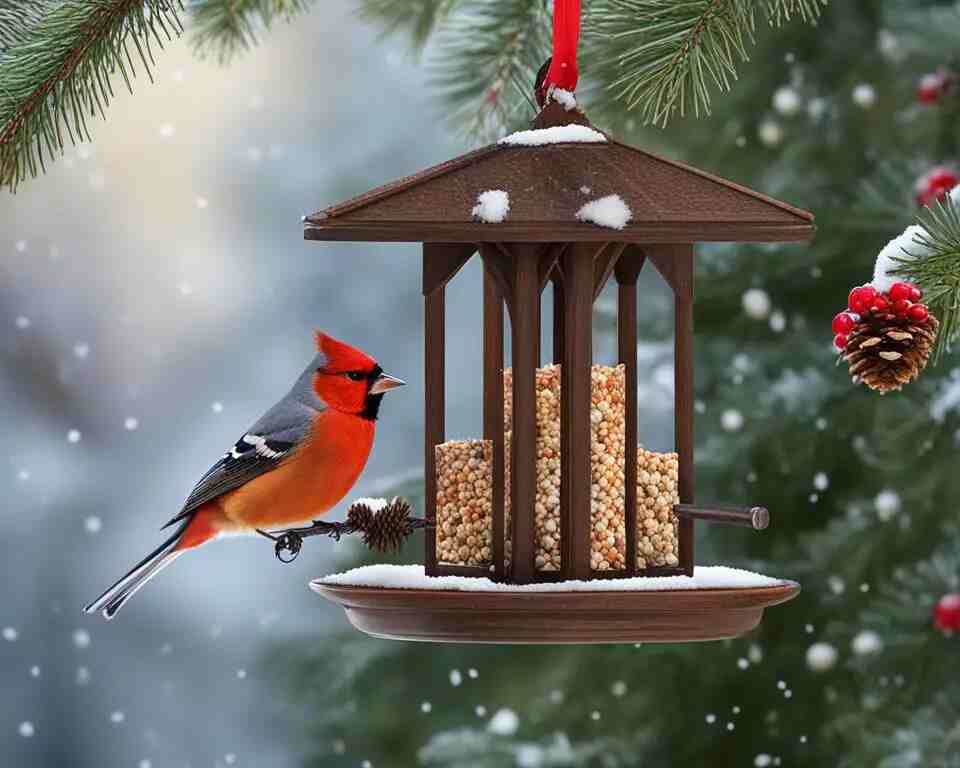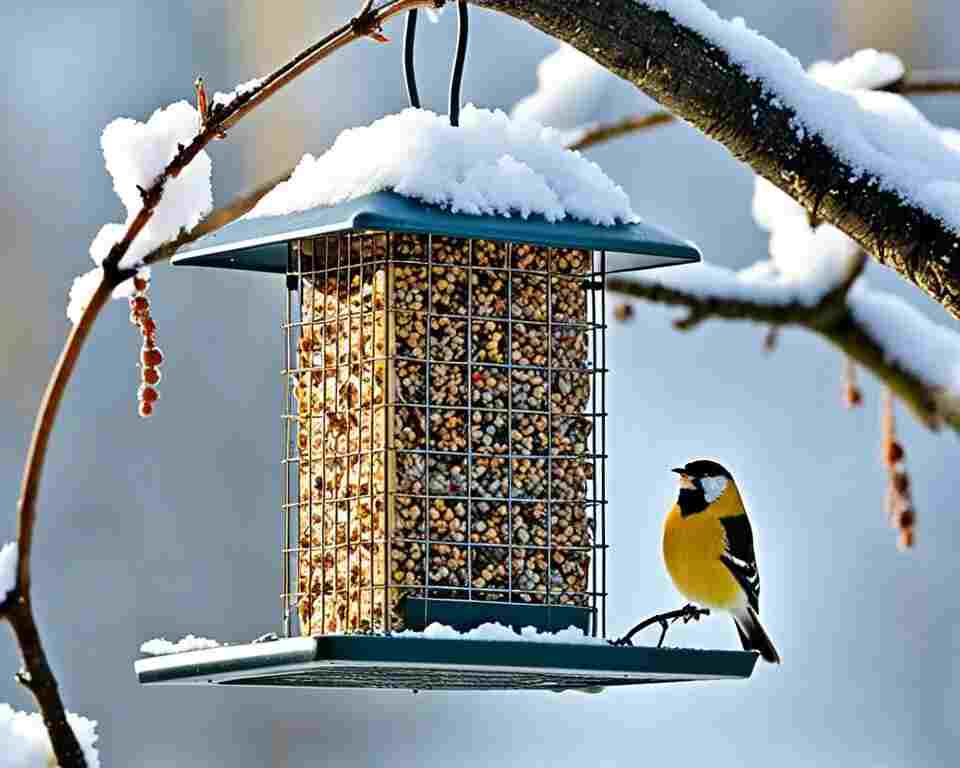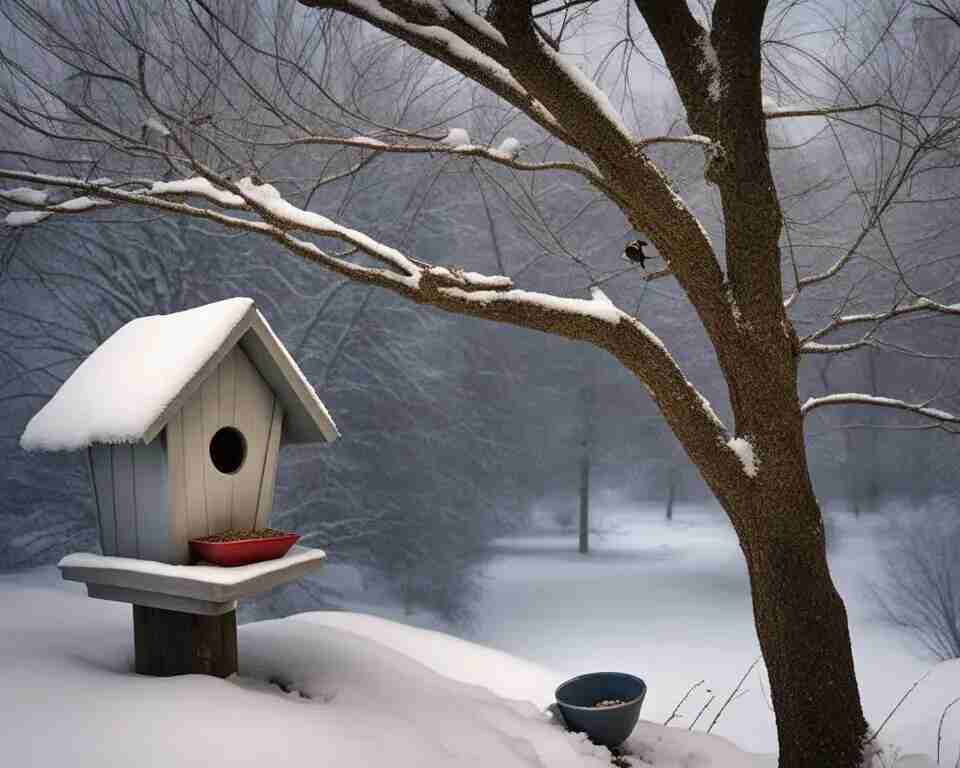Have you ever wondered how to attract more birds to your backyard during the winter months? Contrary to popular belief, it doesn’t require complicated techniques or expensive equipment. With a few simple tips, you can create a welcoming environment that will entice a variety of bird species to visit your yard, even in the coldest of days.
In this article, I will share practical strategies and insights to help you attract more birds in winter. By providing the right foods and creating a safe and welcoming habitat, you can enjoy the beauty and company of these feathered visitors all season long. Get ready to transform your backyard into a haven for winter birds.
Table of Contents
Key Takeaways:
- Attracting birds in winter is easier than you might think.
- Providing the right foods and creating a safe habitat are key.
- Focus on high-fat foods and a variety of seeds to cater to different species.
- Create a bird-friendly environment with shelter options like roosting boxes.
- Maintain your bird habitat by cleaning feeders and providing ice-free water.
How to Attract More Birds in Winter
Attracting winter birds requires understanding their specific needs. To attract more birds in winter, it’s important to provide the right food sources and create a bird-friendly habitat. By following these tips and strategies, you can make your backyard a haven for winter birds.
Providing High-Fat Foods
During the colder months, birds need high-fat foods to sustain their energy levels. Consider offering foods such as suet cakes, which are packed with healthy fats. You can easily place suet cakes in suet feeders, or hang them from tree branches. Another excellent source of fat is peanuts. By offering these high-fat foods, you’ll be attracting birds that rely on them for survival during the winter.
Offering a Variety of Seeds
It’s important to offer a diverse range of seeds to attract different bird species. Common seeds that attract birds include sunflower seeds, nyjer seeds, and millet. Each species has different dietary preferences, so providing a variety of seeds ensures that you’re catering to a wider range of birds. Consider using different types of bird feeders to accommodate different seed varieties.
Creating a Bird-Friendly Habitat
In addition to providing food, creating a bird-friendly habitat is crucial for attracting more birds during winter. Birds need shelter options such as roosting boxes or brush piles to stay protected from the cold weather. Roosting boxes are small, enclosed structures that provide a safe space for birds to roost at night. Brush piles consist of stacked fallen branches and twigs, which create a natural shelter for birds.
By incorporating these shelter options, you’ll not only attract more birds, but also provide them with a safe place to rest and take cover during the winter months. The image below illustrates a bird enjoying feeding in cold weather.
Essentials for Setting the Winter Bird-Feeding Station
Setting up a proper winter bird-feeding station is crucial to attract and sustain a diverse range of bird species. By providing the right conditions and food sources, you can create a welcoming environment that will attract specific bird species during the winter months.
Focus on Feeders That Provide High-Fat Foods
To ensure birds have the necessary energy to survive the colder months, it’s important to offer feeders that provide high-fat foods. Suet and peanuts are excellent choices as they are packed with essential nutrients and calories. These foods will help birds maintain their body temperature and sustain their energy levels in the harsh winter weather.
Offer a Variety of Seeds to Cater to Different Species
Attracting a diverse range of bird species requires offering a variety of seeds. Different birds have different dietary preferences, and by providing a selection of seeds such as sunflower, millet, and nyjer, you can cater to a wider range of species. This variety will enhance the biodiversity in your backyard and create a habitat that is attractive to numerous winter birds.
Ensure Your Feeders Are Accessible and Safe from Predators
When setting up your bird-feeding station, it’s essential to consider the accessibility and safety of the feeders. Place the feeders in locations that are easily visible and accessible to birds. This ensures that they can easily find the feeders and have easy access to the food. Additionally, take precautions to protect the feeders from predators such as squirrels and cats. Use squirrel baffles, pole guards, or other deterrents to keep the feeders safe and secure.
| High-Fat Foods | Variety of Seeds | Accessible and Safe |
|---|---|---|
| Suet | Sunflower | Visible and easily accessible feeders |
| Peanuts | Millet | Protection from predators |
| Nyjer |
Creating a Bird-friendly Winter Refuge
Creating a bird-friendly winter refuge involves providing the necessary elements for birds to find shelter and feel safe in your backyard. By creating a welcoming environment, you can attract more birds and enhance their chances of survival during the winter months.
One of the key strategies for creating a bird-friendly winter environment is to use natural shelters. Trees and shrubs provide excellent cover for birds, offering protection from harsh weather conditions and potential predators. Consider planting native species that provide dense foliage and create a habitat that mimics the birds’ natural surroundings.
In addition to natural shelters, installing roosting boxes can significantly increase the availability of safe nesting sites for birds. These purpose-built boxes provide warmth and protection against cold winds, making them especially attractive to cavity-nesting birds such as chickadees and woodpeckers.
By providing adequate shelter options in your backyard, you can create a winter refuge that meets the needs of a wide range of bird species. Remember to maintain the shelter areas and regularly check for any repairs or maintenance required.
Creating a bird-friendly winter refuge not only benefits the birds but also provides you with the opportunity to observe and appreciate their beauty and behaviors. Take the time to create a welcoming environment, and you’ll be rewarded with the joyful presence of winter birds.
Tips to Maintain Your Winter Bird Habitat
Maintaining your winter bird habitat is crucial to ensure the well-being of the birds that visit your backyard during the colder months. By following these tips, you can provide a safe and inviting environment for the birds, enhancing their chances of survival.
Cleaning and Sanitation of Feeders and Bird Baths
Regular cleaning and sanitation of feeders and bird baths are essential to prevent the spread of diseases among the bird population. Here are some guidelines to keep in mind:
- Clean feeders and bird baths on a regular basis using a mild solution of water and bleach (1 part bleach to 9 parts water).
- Rinse thoroughly and allow them to dry completely before refilling.
- Remove any moldy or wet birdseed from feeders to prevent bacterial growth.
- Scrub feeders and bird baths with a brush to remove debris and droppings.
- Inspect feeders and bird baths for any signs of damage or wear and replace them if necessary.
The Importance of Water: Keeping Bird Baths Ice-Free
Providing a source of fresh water is crucial for birds during the winter months when natural water sources may freeze. Here’s how you can keep bird baths ice-free:
- Use a bird bath heater or a heated bird bath to prevent freezing.
- Place a floating or submersible heater in the bird bath to keep the water temperature above freezing point.
- Remove any ice that forms on the surface of the bird bath regularly.
- Ensure the bird bath is cleaned and refilled with fresh water regularly.
Shelter Strategies: Roosting Boxes and Brush Piles
Offering shelter options for birds during the winter is vital to protect them from harsh weather conditions. Consider implementing the following strategies:
- Install roosting boxes or birdhouses with appropriate dimensions for different bird species.
- Place roosting boxes in sheltered areas, away from direct wind and rain.
- Create brush piles using fallen branches and twigs to provide additional shelter.
- Ensure that brush piles are stable and offer protection from predators.
Tips to Maintain Your Winter Bird Habitat: Summary
By implementing these maintenance tips for your winter bird habitat, you can ensure the health and well-being of the birds that visit your backyard. Regular cleaning and sanitation of feeders and bird baths, providing ice-free water sources, and creating shelter options will contribute to the successful winter survival of the bird population. Take the necessary steps to maintain your winter bird habitat and enjoy the beauty and company of winter birds.
Conclusion
In conclusion, attracting more birds in winter can be a rewarding and enjoyable experience. By implementing the tips and strategies outlined in this article, you can create a welcoming environment that not only adds beauty to your backyard but also provides valuable opportunities for bird-watching.
Enjoying the Beauty and Company of Winter Birds
Attracting birds in winter allows you to witness their captivating beauty up close. Imagine waking up to the melodious songs of cardinals and watching the vibrant feathers of blue jays and finches flutter through your backyard. By providing the right foods and shelter, you can create a paradise for these stunning creatures.
Contributing to Citizen Science Through Winter Birding
Engaging in winter birding also offers a unique chance to contribute to citizen science projects. By observing and documenting the bird species that visit your backyard, you can provide valuable data to researchers and help contribute to avian conservation efforts. So, grab your binoculars, keep a record, and become a citizen scientist while delighting in the presence of winter birds.
Rewarding Both Avian Visitors and Human Observers
By attracting more birds in winter, you not only provide them with a vital food source and safe refuge but also create a rewarding experience for yourself. Bird-watching has numerous benefits for human observers, including stress relief, relaxation, and a deeper connection with nature. So, take pleasure in the intimate interactions with winter birds, observe their behaviors, and marvel at the wonders of the natural world.





